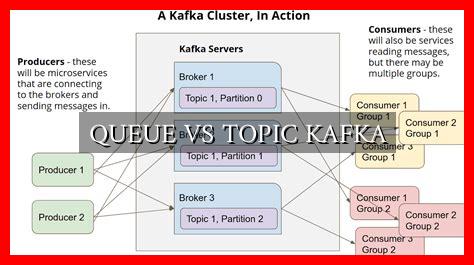-
Table of Contents
Queue vs Topic Kafka: Understanding the Differences
Apache Kafka is a popular distributed streaming platform that is widely used for building real-time data pipelines and streaming applications. One of the key concepts in Kafka is the distinction between queues and topics. In this article, we will delve into the differences between queues and topics in Kafka, their use cases, and how they impact the design of Kafka applications.
Queues in Kafka
Queues in Kafka are known as Consumer Groups. A queue is a way to distribute messages to multiple consumers in a group. Each message is delivered to only one consumer in the group.
. This ensures that each message is processed by only one consumer, enabling load balancing across consumers in the group.
- Messages are delivered to only one consumer in the group
- Enables load balancing across consumers
- Each message is processed by only one consumer
Topics in Kafka
Topics in Kafka are similar to queues but with a key difference. In a topic, messages are broadcast to all consumers who subscribe to that topic. This means that each message is consumed by all consumers who are subscribed to the topic. Topics are useful for scenarios where multiple consumers need to process the same message independently.
- Messages are broadcast to all consumers subscribed to the topic
- Each message is consumed by all consumers
- Useful for scenarios where multiple consumers need to process the same message independently
Use Cases
Queues and topics have different use cases based on the requirements of the application. Queues are typically used in scenarios where messages need to be processed by only one consumer in a group. This is useful for load balancing and ensuring that each message is processed exactly once.
On the other hand, topics are used when multiple consumers need to process the same message independently. This is common in scenarios where different consumers perform different actions based on the same message, such as logging, monitoring, or analytics.
Example Scenario
Let’s consider an e-commerce platform where orders are placed by customers. In this scenario, a queue can be used to process orders one at a time, ensuring that each order is processed by only one consumer. This helps in maintaining order and ensuring that each order is fulfilled correctly.
On the other hand, a topic can be used to broadcast order notifications to multiple consumers, such as inventory management, shipping, and billing systems. Each system can independently process the order notification and perform its specific actions based on the order information.
Conclusion
In conclusion, queues and topics in Kafka serve different purposes and have distinct use cases. Queues are used for load balancing and ensuring that each message is processed by only one consumer, while topics are used for broadcasting messages to multiple consumers who process the message independently. Understanding the differences between queues and topics is essential for designing efficient and scalable Kafka applications.
For more information on Apache Kafka and its concepts, you can visit the official Apache Kafka website.





